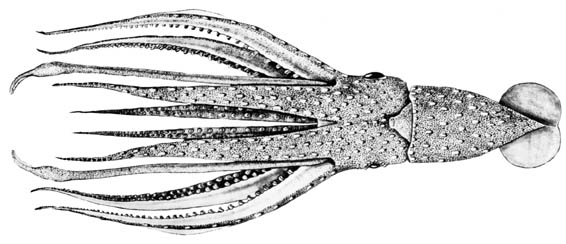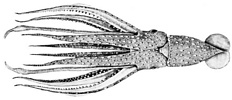Stigmatoteuthis dofleini
Richard E. Young and Michael VecchioneIntroduction
S. dofleini appears to be restricted to the temperate waters of the North Pacific. However, species in the hoylei species group are separated primarily on features of mature males and such males are uncommon in collections. Therefore, the distribution is tentative.
Diagnosis
A histioteuthid
- found in temperate North Pacific waters.
Characteristics
- Reproductive system
- Spermatophore ejaculatory apparatus with single loop.
- Sperm mass 46-60% of SpL.
- Hectocotylus with 2 sucker series throughout.
- Hectocotylus without papillated skin on ventral surface.
Comments
Species of Stigmatoteuthis are easily recognized by the Type 1a photophore pattern of the head which has 3 photophores in the Midline Series and no rogue photophore (see pattern of S. hoylei). S. dofleini is most easily separated from other members of the hoylei-group by the structure of the spermatophore, especially the simple arrangement of the ejaculatory apparatus with a single loop and by its temperate North Pacific distribution.
More details of the description can be found here.
Species Stigmatoteuthis are characterized by the presence of:
- Tentacular clubs
- Medial suckers of tentacular clubs greatly enlarged, more than 4X diameter of minute marginal suckers.
- Photophores
- Type 1a pattern on head (e.g., 3 Midline Series photophores, 3 Basal Arm IV Row photophores and no rogue photophore).
- Basal Row on head with 8 photophores and 3 sawteeth.
- Right Basal Series on head present.
- Ends of arms IV without separate group of compound photophores.
- Compound photophores of large, uniform size and evenly spaced on anterior half of ventral mantle.
- Tubercles
- Absent.
- Mantle
- Skin of the mantle and elsewhere with dermal warts beneath outer epithelium in large squid.
- Viscera
- Mail genitalia paired.
With the exception of the analysis of the head photophores, the above information is from Voss (1969) and Voss, et al. (1998).
Nomenclature
All world-wide specimens in Stigmatoteuthis were considered by Voss (1969) to belong to H. dofleini. Voss et al. (1992) after examining the type of Histiopsis hoylei Goodrich, 1896, placed all known specimens in the synonomy of this earlier named species, Histioteuthis hoylei (Goodrich, 1896). Voss et al., (1998) recognized that the Atlantic form was diffferent and should be called H. arcturi (Robson, 1948). They based the separation primarily on striking differences in the spermatophore and hectocotylus of the mature male. Unfortunately few mature specimens were known for comparisons. The males that represented H. hoylei came from north temperate waters off California and Japan. We have examined specimens from off Hawaii and found they have spermatophores with the distinctive ejaculatory apparatus of H. arcturi from the Atlantic but differ in some features of the hectocotylus. Therefore, the Pacific forms divide into a temperate North Pacific species which carries the name, H. dofleini, and a more southern species, H. hoylei. Instead of placing H. hoylei and H. arcturi in synonomy, we maintain the separation of these species as Voss et al., (1998) list other separating characters such as features of the gladius, beak, web and arm lengths that are not all related to maturity and are based on squids from a wider geographical range. We place all members of the hoylei-group into the genus Stigmatoteuthis.
In this clade of histioteuthids with bilaterally paired male secondary sexual organs, the first species described was Histiopsis hoylei Goodrich 1896. However, the type species of the nominal genus Histiopsis is H. atlantica, which has unpaired male organs and Histiopsis was subsequently placed in the synonomy of Histioteuthis (Voss,1969). Pfeffer (1900) described the genus Stigmatoteuthis, with type species S. hoylei (Goodrich 1896) by monotypy. (This is not the same species as Meleagroteuthis hoylei Pfeffer, 1900 which, according to Nesis, 1987, is a synonym of Histioteuthis meleagroteuthis.) Therefore Stigmatoteuthis Pfeffer 1900 is the valid-genus name designated for a species in this clade.
Life History
A young S. dolfeini from off California (8 mm ML) has been described with the full compliment of photophores along the right eyelid and the distinctive flaps on the arms of the dorsal funnel organ (Voss, et al., 1992).
Figure. Ventral view of small S. dofleini, 8 mm ML, California Current. Drawing from Voss et al. (1992, fig. 143a).
Distribution
Geographical distribution
Type locality: Sagami Bay, Japan. image info
image infoFigure. Distribution chart for S. dofleini. Modified from Voss et al. (1998). We have assumed that distribution records of Voss et al. (1998) off the west coast of the United States and the east coast of Japan belong to S. dofleini.
References
Voss, N. A. 1969. A monograph of the Cephalopoda of the North Atlantic: The family Histioteuthidae. Bull. Mar. Sci., 19: 713-867.
Voss, N.A., K. N. Nesis, P. G. Rodhouse. 1998. The cephalopod family Histioteuthidae (Oegopsida): Systematics, biology, and biogeography. Smithson. Contr. Zool., 586(2): 293-372.
Voss, N. A., S. J. Stephen and Zh. Dong. 1992. Family Histioteuthidae. Smithson. Contr. Zool., No. 513: 73-91.
Young, R. E. 1972. The systematics and areal distribution of pelagic cephalopods from the seas off Southern California. Smithson. Contr. Zool., 97: 1-159.
Title Illustrations
| Scientific Name | Stigmatoteuthis dofleini |
|---|---|
| Location | off Southern California |
| Reference | from Young, R. E. 1972. The systematics and areal distribution of pelagic cephalopods from the seas off Southern California. Smithson. Contr. Zool. 97:1-159. |
| Size | 150 mm ML |
| Copyright | © Richard E. Young |
About This Page
Richard E. Young
Dept of Oceanography
University of Hawaii
Honolulu, Hawaii 96822
USA
National Marine Fisheries Service
Systematics Laboratory
National Museum of Natural History
Washington, D. C. 20560
USA
Page copyright © 2000 Richard E. Young and
Citing this page:
Young, Richard E. and Vecchione, Michael. 2000. Stigmatoteuthis dofleini . Version 01 January 2000 (under construction). http://tolweb.org/Stigmatoteuthis_dofleini/19794/2000.01.01 in The Tree of Life Web Project, http://tolweb.org/









